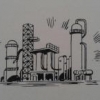Latest Downloads
-
 Water Bath Indirect Heaters
Water Bath Indirect HeatersArt Montemayor - Oct 12 2018 02:35 PM
-
 Petroleum: A Primer for Kansas
Petroleum: A Primer for KansasArt Montemayor - Oct 12 2018 02:27 PM
-
 Spray Tower for Flue Gas Scrubbing Design
Spray Tower for Flue Gas Scrubbing Designankur2061 - May 02 2018 02:31 PM
-
 Selection of Vertical Tanks
Selection of Vertical Tanksankur2061 - Apr 19 2018 07:42 AM
-
 Pressure Drop Calculator for Strainers 1
Pressure Drop Calculator for Strainers 1ankur2061 - Mar 24 2017 02:04 PM
-
 Horizontal Pig Trap System Design Guidelines
Horizontal Pig Trap System Design Guidelinesankur2061 - Jan 14 2017 02:54 PM
-
 Performance Prediction of 3-Stage Propane Refrigeration System
Performance Prediction of 3-Stage Propane Refrigeration Systemankur2061 - Aug 08 2016 02:43 PM
-
 Centrifugal Pump Troubleshooting Checklist
Centrifugal Pump Troubleshooting Checklistankur2061 - Dec 17 2015 08:18 AM
-
 Compressor Troubleshooting Checklist
Compressor Troubleshooting Checklistankur2061 - Sep 08 2015 11:43 AM
-
 Amine Sweetening Unit Preliminary Design
Amine Sweetening Unit Preliminary Designankur2061 - May 19 2015 09:35 AM
Popular Store Titles
 Tank Jacket Calculator
Tank Jacket Calculator
 Specification Sheet Collection
Specification Sheet Collection
 PIPESIZE
PIPESIZE
 Relief Valve Sizing
Relief Valve Sizing
 Rupture Disc Sizing
Rupture Disc Sizing
Chemical and Process Engineering Resources
Submitted Chris Haslego, Nov 21 2011 11:21 AM | Last updated Nov 21 2011 01:29 PM
| Category: | Refining |
| Question: | How can I clean a welded plate heat exchanger and prevent future problems in our reforming unit? |
| Keywords: | welded,plate,heat,exchanger,plugging,increased,pressure,drop,cleaning,in,place,reforming,unit |
| Answer: | BACKGROUNDIn a catalytic reforming unit, we are experiencing an increased pressure drop across a welded plate heat exchanger.ANSWERYou have essentially two options:1. Contact the manufacturer and see if they have a service department that can perform a CIP (Cleaning in Place). This is the only way to clean a truly welded plate unit.2. Buy a new unitOther suggestions would be the following: During a shutdown, check the ports to see if there is obvious plugging in the ports. If not, then the plugging is probably equally distributed in the channels. I'm not sure what kind of plugging you'd be getting in a gas plant, but if there is any risk of suspended solids entering this exchanger, then you need to filter the streams before they enter the unit. You'll need to know what the free channel spacing is of the unit. Then, filter any particles over 75% of the free channel spacing.FOLLOW-UPIf you are running a Catalytic Reformer plant I'm speculating that you may have entrained catalyst fines over into the effluent product stream coming out of the reformer. I know I'm speculating, but somehow you have plugged the exchanger and this can only be a hard, unsoluable solid if the exchanger is in hot service. I also suspect the plug is not going to be capable of being dissolved and, consequently, the exchanger must be sacrificed. Presumably, the exchanger came as original equipment with the reformer plant and was designed to work well. If the process design allows for the possible entrainment of solids, a protective filtering system must have been designed into the plant. If the filtering system exists upstream of the plate exchanger, it must have failed or it might have been by-passed for some reason. Regardless, the result is that you now face an increased pressure drop across the exchanger that is subject to getting worse and shutting you down. If the exchanger is running hot and you can bypass it, I would try to inspect it while it is off the line. There is a chance that you could discover the tell-tale signs of solid plugging in the gas inlet nozzle area. If you do not find the reason for the plugging, you still wind up with same bad news: the exchanger is probably not salvageable because of the prohibitive labor and repair costs. The reason for trying to find the cause is to design against the effect taking place again in the future.I suspect you would be well advised to prepare for an upcoming exchanger replacement and eventual scraping of the existing unit. The harm has already been done to a unit that simply is not designed (nor expected) to tolerate solids' inclusion in the process stream. You should identify the source of the plugging and take positive steps to mitigate it in future operations. A plate heat exchanger is very economically and size efficient and my hunch is that you would be better off with a similar replacement instead of a shell and tube design. However, you must protect the plate exchanger from solids in the process stream. You are almost obligate to go with the welded (sealed) design because of the safety hazards involved with a gasketed plate design in this critical service. The fact that you plugged the unit is not the fault of the plate exchanger design. You should not have to tolerate solids in your reformed gas streams outside of the reformer. |
Forum Quick Links
Tech Q & A Category List
-
 Bulk Solids
Bulk Solids
-
 ChE Outside the Plant
ChE Outside the Plant
-
 Chemical Process Business
Chemical Process Business
-
 Chemistry Basics
Chemistry Basics
-
 Corrosion
Corrosion
-
 Equipment Design
Equipment Design
-
 Experimentation and Testing
Experimentation and Testing
-
 Fluid Dynamics
Fluid Dynamics
-
 Heat Transfer Technology
Heat Transfer Technology
-
 Industrial Utilities
Industrial Utilities
-
 Mass Transfer
Mass Transfer
-
 Physical Property Information
Physical Property Information
-
 Plant Basics
Plant Basics
-
 Plant Economics
Plant Economics
-
 Preparing to Become an Engineer
Preparing to Become an Engineer
-
 Process Control
Process Control
-
 Reactions and Processes
Reactions and Processes
-
 Refining
Refining
-
 Safety
Safety
-
 Separation Technology
Separation Technology
-
 The Environment
The Environment
-
 Thermodynamics
Thermodynamics

 FB
FB



0 Comments